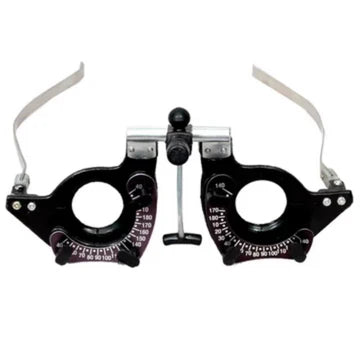
TRAIL FRAME
Share
A trial frame is an essential tool in optometry and ophthalmology used for performing subjective refraction and determining a patient's eyeglass prescription. It is a versatile, adjustable device that holds different lenses in front of the patient's eyes during an eye examination, allowing the practitioner to assess vision and refractive errors effectively.
Key Features:
-
Adjustable Frame:
- The trial frame is made from lightweight materials and is designed to be adjustable for comfort and fit. It can accommodate various head sizes and shapes to ensure a secure and comfortable position for the patient.
-
Lens Holders:
- The frame has holders on both sides, allowing the insertion of different prescription lenses (sphere, cylinder, and prism) as needed. This enables the eye care professional to test various lens combinations to find the optimal prescription.
-
Interchangeable Lenses:
- A set of trial lenses, typically made of glass or plastic, can be inserted into the frame. These lenses come in various powers and types (e.g., convex, concave, astigmatic) to assess different refractive errors such as myopia, hyperopia, and astigmatism.
-
Pupil Distance Adjustment:
- The trial frame features adjustable temples to ensure proper alignment with the patient’s pupils. This adjustment is crucial for accurate lens positioning and vision testing.
-
Nose Pads:
- Many trial frames come with soft nose pads that provide comfort during prolonged use, ensuring that the frame sits securely on the nose without causing discomfort.
-
Temples and Headband Options:
- The frame may include adjustable temples or an optional headband for added stability, particularly useful for children or patients who may have difficulty keeping the frame in place.
Applications:
-
Subjective Refraction:
- The primary use of trial frames is to determine a patient’s refractive error through subjective refraction testing. Patients can compare different lens options to find the clearest vision.
-
Vision Testing for Glasses:
- Eye care professionals use trial frames to simulate different prescriptions and test the patient’s visual acuity, ultimately determining the most suitable lens power for their eyeglasses.
-
Orthoptic Assessments:
- In certain cases, trial frames may also be used in orthoptic assessments to evaluate binocular vision and eye alignment.
-
Contact Lens Fitting:
- Trial frames can be utilized to determine the necessary refractive correction prior to fitting contact lenses, ensuring compatibility with the patient’s vision needs.
Benefits:
-
Versatility:
- The ability to interchange lenses allows for a wide range of refraction tests, making trial frames adaptable for various patient needs.
-
Patient Engagement:
- The subjective nature of testing with trial frames encourages patient participation in the examination, leading to more accurate prescriptions based on their preferences.
-
Cost-Effective:
- Trial frames are generally more affordable than more complex refraction equipment, making them accessible for many eye care practices.
Limitations:
-
Manual Adjustment Required:
- Unlike automated refractors, trial frames require manual adjustments and lens changes, which can be time-consuming.
-
Learning Curve:
- New practitioners may require practice to efficiently use trial frames and interpret patient responses accurately.
The trial frame is a crucial instrument in the optometric field, enabling eye care professionals to conduct thorough visual assessments and determine accurate prescriptions for corrective lenses. Its design facilitates patient comfort and engagement, making it an invaluable tool in providing quality eye care.
